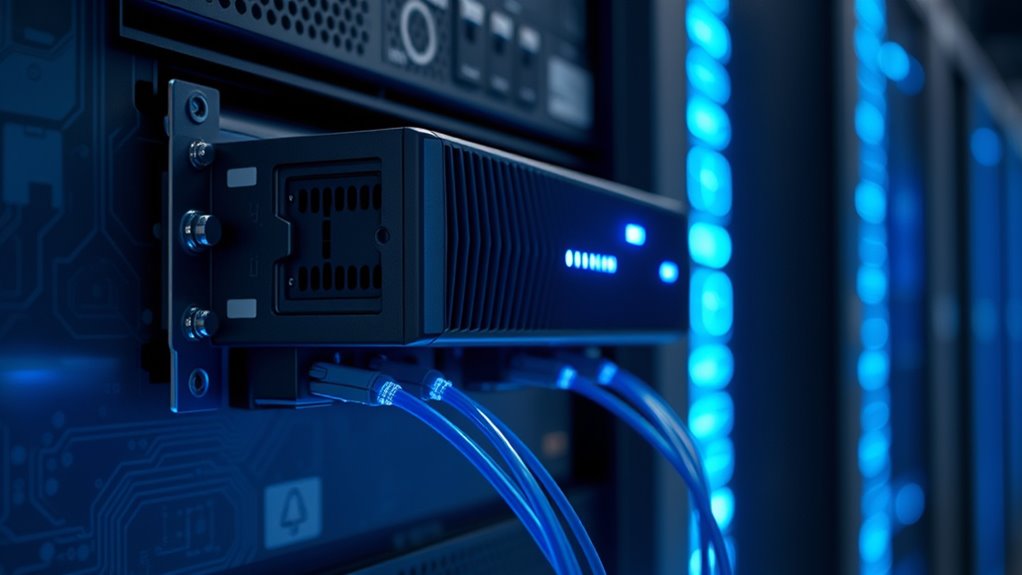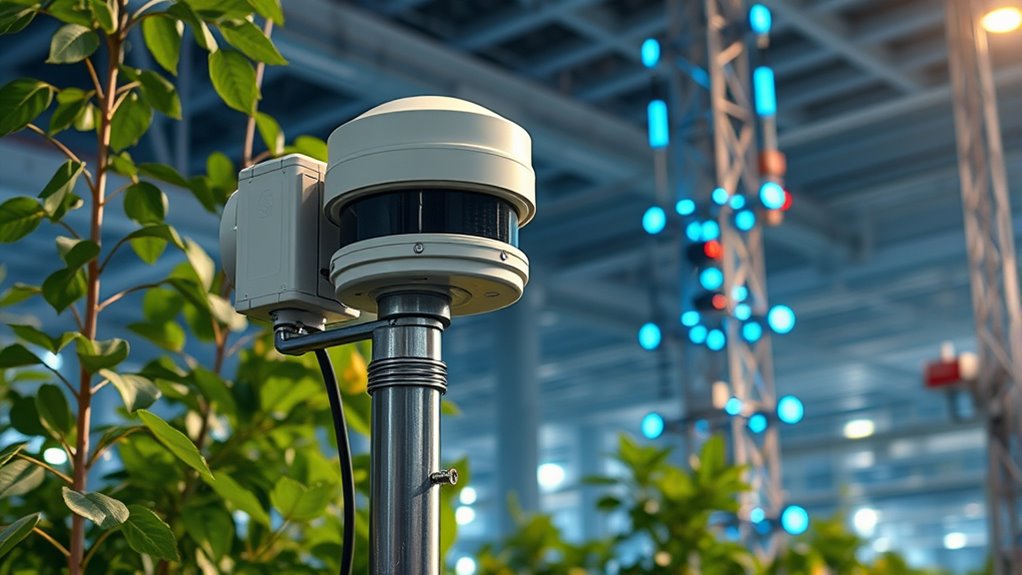Edge computing processes data close to its source, meaning you analyze and filter information locally rather than relying solely on centralized cloud servers. This approach reduces latency, speeds up decision-making, and enhances security by keeping sensitive information protected during processing. It’s widely used in industries like manufacturing, healthcare, transportation, and infrastructure. Technologies like 5G and IoT expand these capabilities further. Keep exploring to discover how these innovations shape the future of data management at the edge.
Key Takeaways
- Edge computing processes data near its source, reducing latency and enabling faster decision-making.
- It involves local devices like sensors, gateways, and micro data centers for real-time data analysis.
- Combining edge and cloud infrastructure optimizes workload distribution and improves system efficiency.
- It enhances security and privacy by processing sensitive data locally before transmission.
- Edge computing supports applications in manufacturing, healthcare, transportation, and smart infrastructure.
Understanding the Core Principles of Edge Computing

To understand the core principles of edge computing, it’s essential to recognize that processing data close to its source is at the heart of this technology. Instead of sending all data to a centralized cloud, you analyze and filter information locally, near devices like sensors or cameras. This approach minimizes latency, allowing for real-time responses critical for applications like autonomous vehicles or industrial automation. You combine both centralized cloud systems and distributed edge nodes, balancing the workload for better performance. By processing data at the edge, you reduce bandwidth consumption and enhance security by keeping sensitive information local. This hybrid model ensures that data is managed efficiently, swiftly, and securely, making edge computing a fundamental part of modern digital infrastructure. Additionally, integrating predictive analytics into edge systems can further optimize decision-making processes at the source.
Key Advantages of Processing Data Locally

Processing data locally reduces the time it takes to get responses, so you can act instantly in critical situations. It also cuts down on bandwidth use by sending only essential information to the cloud, saving costs and network resources. With local processing, you gain faster reactions and more efficient data handling, improving overall system performance. Additionally, understanding storage considerations ensures that data remains safe and accessible during processing.
Reduced Latency Impact
Have you ever experienced delays in real-time systems? Edge computing reduces those delays substantially. By processing data near its source, you prevent the time needed to send information to distant servers. This is essential for applications requiring instant responses. Here’s how it helps:
- Faster decision-making: Local processing ensures immediate insights, critical for autonomous vehicles or industrial automation.
- Reduced lag: Minimizes delays caused by network congestion or long-distance data transmission.
- Enhanced responsiveness: Real-time alerts and adjustments become possible, improving safety and efficiency.
- Security considerations: Processing data locally can also help mitigate certain security vulnerabilities, ensuring sensitive information remains within a controlled environment.
This proximity of processing power makes systems more agile and reliable. Instead of waiting for cloud responses, you get instant feedback, enabling smarter, faster operations across various industries. Reduced latency is a core benefit that unleashes the full potential of edge computing.
Lower Bandwidth Usage
By handling data locally at the edge, you considerably reduce the amount of information that needs to be transmitted to the cloud. This means only relevant insights, summaries, or alerts are sent, minimizing network load. You avoid overwhelming bandwidth with raw data streams from sensors, cameras, or devices. As a result, your network experiences less congestion, and data transfer costs decrease markedly. This efficiency is especially crucial in environments with limited or expensive connectivity. By filtering and processing data at the source, you free up bandwidth for essential communications and avoid bottlenecks. Additionally, high-quality processing ensures more accurate and timely insights, further enhancing system performance. This streamlined approach not only conserves resources but also ensures your system remains responsive and reliable, even during network disruptions. Ultimately, lower bandwidth usage boosts operational efficiency and reduces operational costs.
How Edge Devices Enable Real-Time Decision-Making

Edge devices process data instantly at the source, allowing you to make quick decisions without waiting for cloud analysis. This localized processing enables real-time actions, like adjusting machinery or alerting personnel immediately. By handling data on-site, you can respond faster and improve operational efficiency. Incorporating various yoga styles into your routine can also enhance mental clarity and physical well-being, supporting overall health.
Instant Data Processing
How do edge devices enable real-time decision-making? They process data instantly at the source, eliminating delays caused by transmitting to distant servers. This immediate analysis allows you to respond quickly to changing conditions. Here’s how:
- Local Processing Power: Edge devices analyze data on-site, providing instant insights without waiting for cloud responses.
- Prioritized Data Filtering: Only essential information is sent to the cloud, reducing processing time and network congestion.
- Automated Responses: Devices can trigger actions immediately—like adjusting machinery or alerting personnel—based on real-time data.
Localized Decision Actions
Localized decision actions allow edge devices to act immediately on data they collect, without waiting for instructions from a central system. This rapid response is vital for scenarios like autonomous vehicles, industrial automation, and healthcare monitoring, where delays can be costly or dangerous. By processing data locally, your devices can identify anomalies, trigger alerts, or adjust operations in real-time, ensuring safety and efficiency. This capability reduces reliance on cloud connectivity, enabling continuous operation even during network disruptions. It also minimizes latency, so actions happen instantly, improving overall system performance. With localized decision-making, you gain faster insights and more control at the source, empowering your devices to respond proactively and autonomously, which is essential in time-sensitive applications. Additionally, incorporating vibrational energy principles can help optimize device performance and responsiveness in certain environments.
Industry Sectors Transforming With Edge Integration

Numerous industry sectors are experiencing transformative changes as they adopt edge integration to boost efficiency and responsiveness. You’ll see rapid improvements in how operations run and how quickly decisions are made.
Here are three key sectors leading the charge:
- Manufacturing: Real-time equipment monitoring and predictive maintenance reduce downtime and increase productivity.
- Healthcare: Wearables and remote monitors process patient data locally, ensuring faster response times and enhanced privacy.
- Transportation: Connected vehicles and traffic systems rely on edge for instant data processing, improving safety and traffic flow.
Infrastructure and Technologies Powering Edge Solutions

The backbone of effective edge computing lies in its robust infrastructure and advanced technologies. You’ll find edge devices like IoT sensors, cameras, and gateways that process data locally, reducing latency. Edge servers or micro data centers handle more intensive tasks near data sources. 5G networks boost connectivity, supporting faster, low-latency communication for countless devices. Often, edge and cloud systems work together, with data filtered at the source before transmission. This synergy optimizes performance and minimizes bandwidth use. As shown below, understanding the core components helps you grasp how these technologies interplay:
| Component | Function | Example |
|---|---|---|
| IoT Sensors | Data collection at the source | Temperature sensors |
| Edge Devices | Local data processing | Gateways, cameras |
| Edge Servers | Heavy computation near data source | Micro data centers |
| 5G Networks | Fast, reliable communication | Mobile network towers |
| Cloud Integration | Centralized data storage and analysis | Cloud platforms |
A comprehensive understanding of edge infrastructure is essential for designing efficient and scalable systems.
Ensuring Security and Privacy at the Network Edge

As edge computing distributes data processing across many devices and locations, ensuring security and privacy becomes more critical than ever. You need to implement strategies that protect sensitive information and prevent breaches at each node. Here are key steps:
- Encrypt data locally to prevent unauthorized access during processing and storage on edge devices.
- Use strong authentication and access controls to restrict who can interact with your edge systems.
- Regularly update firmware and software to patch vulnerabilities and defend against emerging threats.
The Role of 5G and IoT in Expanding Edge Capabilities

With the deployment of 5G networks, IoT devices can now communicate faster and more reliably than ever before, substantially expanding the capabilities of edge computing. This boost in connectivity enables real-time data processing at the source, reducing latency and bandwidth use. You can deploy more connected devices, such as sensors and cameras, without straining networks or cloud resources. Here’s how 5G and IoT amplify edge computing:
| Benefit | Impact |
|---|---|
| Faster Data Transfer | Enables instant decision-making |
| Increased Device Density | Supports large-scale IoT deployments |
| Improved Reliability | Ensures continuous operations |
Challenges in Managing Distributed Edge Systems

Managing distributed edge systems presents significant challenges because overseeing numerous devices spread across various locations requires complex coordination and robust security measures. You need to guarantee consistent performance, manage device updates, and handle connectivity issues across all sites. Additionally, security remains a top concern, as each device can become an entry point for threats. To tackle these challenges, focus on:
- Device Management: Keeping firmware, software, and security patches up to date across a vast network.
- Security Protocols: Implementing strong encryption, authentication, and threat detection at every node.
- Data Consistency: Ensuring synchronized, accurate data collection and processing despite network disruptions.
Balancing these factors demands sophisticated tools and strategies, making the management of distributed edge systems complex but essential for reliable operations.
Future Directions and Innovations in Edge Computing

The future of edge computing is driven by rapid advancements in artificial intelligence, machine learning, and 5G connectivity, which are enabling smarter and more autonomous systems. You’ll see more sophisticated AI models running directly on edge devices, reducing reliance on cloud processing and cutting latency further. Innovations will focus on seamless integration between edge and cloud, optimizing data flow and resource management. Expect to see edge-native hardware designed specifically for AI workloads, with increased processing power and energy efficiency. Edge security will evolve with adaptive threat detection and automated responses. Additionally, decentralized architectures and micro data centers will grow, supporting scalable, resilient networks. These developments will liberate new applications in autonomous vehicles, smart cities, and industrial automation, transforming how you process, analyze, and act on data locally. As edge computing technology advances, vetted hardware options will become increasingly important for ensuring reliable and secure operation in diverse environments.
Frequently Asked Questions
How Do Edge Computing Deployments Impact Overall Network Bandwidth?
You’ll see that edge computing reduces overall network bandwidth by processing data locally, so only relevant insights are sent to the cloud. This minimizes the volume of data transmitted, lowering bandwidth costs and easing network congestion. You also benefit from faster responses and improved security, as sensitive data stays at the source. Overall, it creates a more efficient, scalable network that handles increasing device connections without overwhelming your infrastructure.
What Are Common Security Risks Specific to Edge Devices?
You face security risks like device tampering, unauthorized access, and data interception at the edge. Since edge devices often operate in less secure environments, hackers can exploit vulnerabilities to gain control or steal sensitive info. Weak authentication, outdated firmware, and poor network protections increase these dangers. To protect your infrastructure, you should implement strong security measures, keep devices updated, and monitor for suspicious activity regularly.
How Is Data Consistency Maintained Across Multiple Edge Nodes?
You maintain data consistency across multiple edge nodes by implementing synchronization protocols like distributed databases or consensus algorithms such as Paxos or Raft. You also guarantee regular data replication, conflict resolution strategies, and timestamping for updates. Using secure, reliable communication channels and monitoring tools helps you detect and resolve inconsistencies quickly. This way, you keep data accurate and synchronized, even when nodes operate independently or experience intermittent connectivity.
What Are the Key Cost Factors for Scaling Edge Infrastructure?
Did you know that by 2025, over 75 billion IoT devices will be connected worldwide? When scaling edge infrastructure, your key costs include deploying and maintaining hardware like sensors, gateways, and micro data centers. You also invest in network upgrades, security measures, and management tools. Remember, these expenses grow with device proliferation, so planning for ongoing upgrades and security is essential to keep costs manageable and performance ideal.
How Does Edge Computing Integrate With Existing Cloud Platforms?
You integrate edge computing with existing cloud platforms by creating a hybrid architecture where processing happens locally at the edge, and only relevant data is sent to the cloud for further analysis or storage. This setup allows you to leverage cloud scalability and management tools while reducing latency, bandwidth costs, and security risks. You can synchronize data seamlessly, enabling real-time decision-making and maintaining centralized control alongside decentralized processing.
Conclusion
Imagine your data as a river flowing toward the ocean. Edge computing acts like a dam, allowing you to control and harness that flow instantly at the source. By processing data locally, you gain faster insights and better security. As industries embrace this shift, you’re positioned at the forefront of a technological revolution — where decisions happen in the blink of an eye, transforming how we live and work every day.









